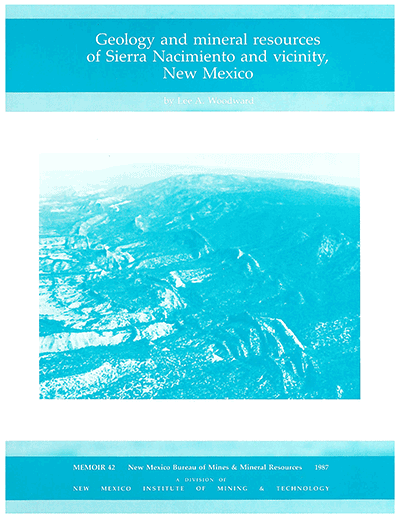
Memoir 42—Geology and mineral resources of Sierra Nacimiento and vicinity, New Mexico
By L. A. Woodward, 1987, 84 pp., 2 tables, 41 figs., index, 1 sheet, scale 1:100,000.


This is a final, comprehensive report of a geologic mapping project by the author and his students begun in 1970 and completed in 1980. Twelve previously published 7½-min quadrangles are the primary sources of information for the rock descriptions, structural interpretations, and mineral and energy resources evaluations published in this volume, as well as for a generalized bedrock geologic map sheet with structure sections. The 12 previously published 7½-min quadrangles include Geologic Maps 25–28, 32–35, 37, 39, 45, 46, and 47.
Precambrian igneous, metasedimentary, and meta-igneous rocks of Proterozoic age occur in two major outcrop areas in the Nacimiento area. Clastic sediments and volcanic rocks accumulated and underwent regional synkinematic metamorphism prior to emplacement of plutonic igneous and meta-igneous rocks that range in composition from ultramafic to leucogranitic. Syenite of probable Ordovician or perhaps Cambrian age intrudes Precambrian rocks and is nonconformably overlain by Paleozoic strata.
Paleozoic strata, having a maximum composite thickness of 1,782 m (5,846 ft), include Mississippian, Pennsylvanian, and Permian units. Mississippian beds, which include, in ascending order, the Arroyo Peñasco and Log Springs Formations, are thin and only locally present. Pennsylvanian beds, which include, in ascending order, the Osha Canyon, Sandia, and Madera Formations, are marine deposits having a maximum thickness of 541 m (1,775 ft). Permian units are continental clastics and are, in ascending order, the Abo Formation, the Yeso Formation, the Glorieta Sandstone, and the Bernal Formation.
Mesozoic strata have a maximum composite thickness of 2,847 m (9,340 ft) and include mainly clastic terrestrial deposits of Triassic and Jurassic age and mainly clastic marine Cretaceous beds. In ascending order the units are the Chinle Formation (Triassic); the Entrada Sandstone, Todilto Formation, and Morrison Formation (Jurrasic); and the Dakota Formation, Mancos Shale, Mesaverde Group, Lewis Shale, Pictured Cliffs Sandstone, and Kirtland Shale and Fruitland Formation undivided.
Terrestrial deposits of Paleocene and Eocene age include, in ascending order, the Ojo Alamo Sandstone, the Nacimiento Formation, and the San Jose Formation; these units have a maximum composite thickness of 709 m (2,325 ft). Three different facies of a Miocene continental deposit up to 305 m (1,000 ft) thick comprise the Zia Sand, the Abiquiu Formation, and an unnamed volcaniclastic unit. Volcanics of the Paliza Canyon Formation (Pliocene) and the Bandelier Tuff (Quaternary) are present locally. The Nacimiento uplift was initiated during the Laramide and consists of a block tilted eastward and bounded on the west by reverse and thrust faults, with at least 3,048 m (10,000 ft) of structural relief between the highest part of the uplift and the adjacent San Juan Basin. The uplift is internally segmented by high-angle faults. Laramide structures formed in a regional compressive stress field complicated by right shift between the uplift and the San Juan Basin, whereas the late Cenozoic evolution of the Rio Grande rift occurred as a result of crustal extension. Rejuvenation of some Laramide structures occurred during the late Cenozoic deformation.
Natural gas has been produced from the South Blanco Pictured Cliffs field in the Regina 7½-min quadrangle, and the potential exists for the discovery of additional hydrocarbons. Copper has been extracted from sandstone-type deposits in the Chinle Formation, but the potential for additional commercial production is low. Numerous occurrences of uranium-bearing minerals and radioactive anomalies have been reported, but, to date, only minor production is recorded for five localities. Travertine, gravel, and gypsum are present, but only the gypsum and gravel have been exploited. Coal was mined underground, but currently no coal is being mined commercially.
$16.75
Buy
Now
Also available as a free download.
Download
| File Name | Size | Last Modified |
|---|---|---|
| Memior_42.pdf | 16.96 MB | 01/19/2021 10:03:02 AM |



